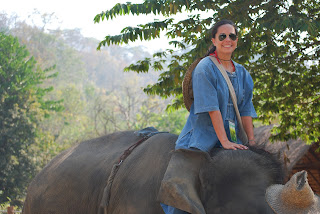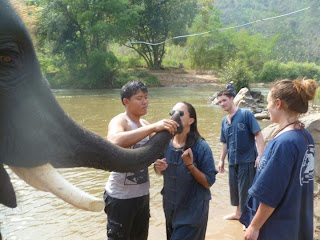* NOTE: This is a very long blog post. I couldn't help it. I wanted to capture for myself and all of you (!) the magnificent history and spectacle of the Angkor Wat and other temples.
When one googles the Seven Wonders of the World, a lot of lists pop up. There are natural wonders and man-made wonders as well as wonders from medieval times, modern times, Florida (!)....In chatting with friends who had visited Angkor Wat in Siem Reap, Cambodia, it was clear that any list of man-made ancient wonders should have this remarkable temple complex included. After visiting, I couldn't agree more. The juxtaposition of long-standing history (massive and intricate temples build BY HAND in the 12th century and still standing after centuries of neglect) and the recent past (destruction of an entire generation of innocent people by the Khmer Rouge, and the subsequent rebuilding of a nation's spirit) is truly incredible to witness.
When one googles the Seven Wonders of the World, a lot of lists pop up. There are natural wonders and man-made wonders as well as wonders from medieval times, modern times, Florida (!)....In chatting with friends who had visited Angkor Wat in Siem Reap, Cambodia, it was clear that any list of man-made ancient wonders should have this remarkable temple complex included. After visiting, I couldn't agree more. The juxtaposition of long-standing history (massive and intricate temples build BY HAND in the 12th century and still standing after centuries of neglect) and the recent past (destruction of an entire generation of innocent people by the Khmer Rouge, and the subsequent rebuilding of a nation's spirit) is truly incredible to witness.
Siem Reap is an up-and-coming charming little town located in the north of Cambodia. Until the early 1900's when the French arrived, it was nothing more than a tiny village. However, with the influence of the French, it became a cultural hub of Cambodia. Like all other cities in Cambodia during the Khmer Rouge regime, Siem Reap was evacuated in the mid 1970's and all citizens were forced to the countryside. Since regaining independence, the Cambodians have been rebuilding the city's bustling vibe and cultural charm (it has a lively French Quarter) and leveraging its close proximity (a few km) to the Angkor temples to remake itself into a top Asian tourist destination. It was delightful to spend a weekend there.
 |
| The best guide ever! |
As a funny aside, he called toilets the "happy house". So whenever we needed a break, which was often given how much water we were drinking to stay hydrated in the summer heat, we asked for a "happy house". So charming.
Anyhoo, we laid out our plan of attack for the day and then set out to be awed and inspired. Here's a bit of what we learned and experienced:
Stop 1: Angkor Wat
Built in the early part of the 12th century, it's known as the 'city temple'. Angkor Wat was commissioned by the Hindu king Suryavarman II to serve as a dedication to Vishna and ultimately as his tomb. (Interestingly, in the late 13th century, Angkor switched to Buddhist use and still is today.) According to Sokk, the 2 square km city-temple complex took 40 years to build and enlisted 385,635 people, 40,000 elephants and 24,000 boats which carried extremely large sandstones from a quarry located 50 km away. The fact that the structures and surrounding moat were built with no modern equipment is remarkable. Even more so that no bindings were used between the stones in building the actual temples!
 |
| Angkor Wat |
 |
| The beautiful ruins of Angkor Wat |
 |
| Me inside the innermost courtyard of Angkor Wat |
 |
| headless Buddhas |
As we walked through the temple grounds, we encountered young monks walking the grounds in their brightly colored orange robes and small grey monkeys hoping for a nibble or snack from an unsuspecting tourist. But one of the most special parts of exploring this incredible complex was coming across a blind monk who was sitting and chanting amongst Buddhas with incense burning and sunlight streaming in around him. I gave a US$1 donation for a red prayer bracelet that the monk tied to my wrist while chanting and smiling; once tied, he blew on the inside of my wrist to bless the bracelet and me for good tidings and travels. I haven't removed it since.
 |
| The blind monk |
Stop 2: Anghor Thom
Anghor Thom translates to the "great city" in Khmer, and served as the last and one of the most enduring capitals in Cambodia. There are two main draws to Anghor Thom - the Bayon Temple and the bridge.
Bayon Temple was a state temple built between 1116-1281 from a red-colored soil called laterite that was dried and carved into large bricks. The Bayon architectural style is known for the red color and its grandness in scale. Twenty years before it was completed, it was transitioned to be the first Buddhist temple in the region and represents the intersection between heaven and earth. There were 54 towers to symbolize the 54 Khmer provinces but only 37 of the towers remain today. The temples are most famous for the (massive) 4 smiling faces carved into them which are meant to represent compassion, sympathy, charity, and equality.
 |
| The faces of Angkor Thom |
 |
| One of the Demons |
 |
| The Gods and Me |
At each stop, I had a new "favorite" as each had really interesting and unique characteristics. But I must say, Banteay Srei, which means 'citadel of the women', was a true delight. We had to pay our driver an extra US $10 to drive the extra few kilometers to it, and I am so happy we did. Banteay Srei is known for its sheer beauty, for it is constructed of a pink sandstone and has truly intricate carvings covering the surfaces. Construction began in 967 AD upon commission by a Brahman (priest) as a dedication to the Hindu god, Shiva. What was so cool was that the buildings appeared almost miniature in size compared to the large scale of the other temples we had seen thus far. The carvings were incredibly detailed and well preserved especially considering that the temple lay undiscovered without maintenance for many centuries, potentially from the 14th century until 1914. There are small sanctuaries with statues of Hindu gods throughout as well as small libraries. What a charming and beautiful spot!
 |
| Amazing carvings considering they are over 1000 years old! |
 |
| I loved the beauty of these buildings |
Stop 4: Pre Rup (The Royal Crematorium)
On the way to our last stop of the day, we buzzed by Pre Rup long enough to take a few photos but did not go in. There are crematorium buildings throughout Cambodia, but this one (built starting in 941 AD) is thought to have been built by the king Rajendravarman II to serve as a royal crematorium. We had an interesting conversation here about whether Cambodians tend to be buried or cremated; Sokk said it's about 50/50.
Stop 5: Ta Prohm
Now, I have never seen the film "Tomb Raider" but if you have, you'd instantly recognize this temple complex. Surrounded by jungle, Ta Prohm has largely been 'preserved' (i.e., without restoration) as it was found when rediscovered in the early 1900's. There are MASSIVE trees growing in and through the main temples. Originally built in 1186, Ta Prohm was a Buddhist temple known as Rajavihara or "monastery of the king" as a dedication to the king's mother. What's fascinating are inscriptions that have been found that detail the working nature of the complex....Close to 12,500 people were required to live and worship in temple. To support and service that community, there were 3,000 villages housing 80,000 people within the temple grounds.
The trees and roots that have grown throughout the temples are spectacular. I have never seen anything quite like it. The roots were hundreds of meters long and many were almost a meter in width! There was an air of mystery and sadness as we traversed through the temples, but also of beauty and peacefulness as well. To see an ancient man-made structure overcome with the forces of nature was certainly something I will never forget.
Now, I have never seen the film "Tomb Raider" but if you have, you'd instantly recognize this temple complex. Surrounded by jungle, Ta Prohm has largely been 'preserved' (i.e., without restoration) as it was found when rediscovered in the early 1900's. There are MASSIVE trees growing in and through the main temples. Originally built in 1186, Ta Prohm was a Buddhist temple known as Rajavihara or "monastery of the king" as a dedication to the king's mother. What's fascinating are inscriptions that have been found that detail the working nature of the complex....Close to 12,500 people were required to live and worship in temple. To support and service that community, there were 3,000 villages housing 80,000 people within the temple grounds.
 |
| Beautiful ruins |
 |
| Massive Tree Root |
 |
| Way cool...a carving of a triceratops! |
 |
| Me at the famous site from Tomb Raider |
 |
| Christian & Me....check out those crazy tree roots! |
 |
| Sokk thought this was hilarious. I didn't know what I was pointing at until I saw the photo later! |
I hope you enjoyed reading this as much as I enjoyed capturing my memories.
Until next time....
xo
































